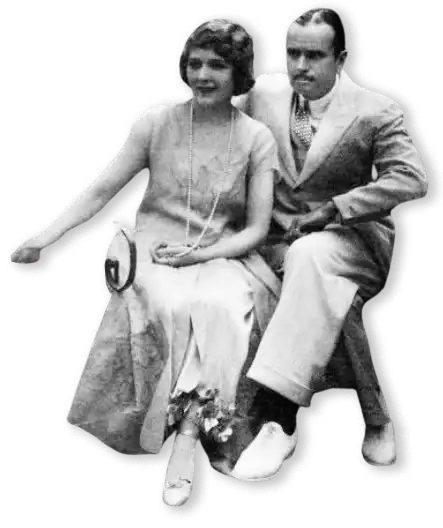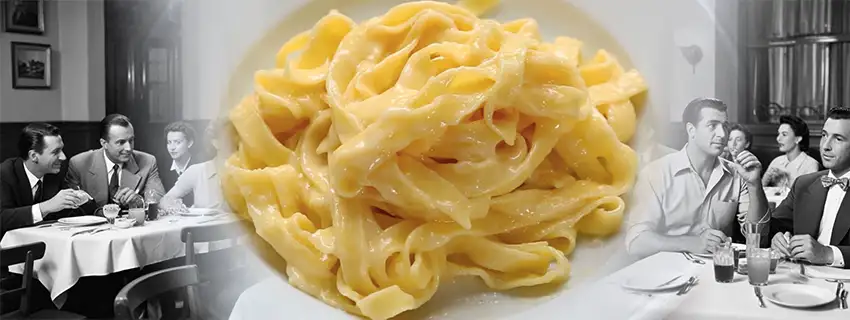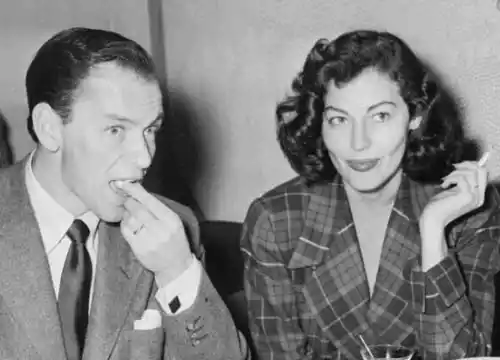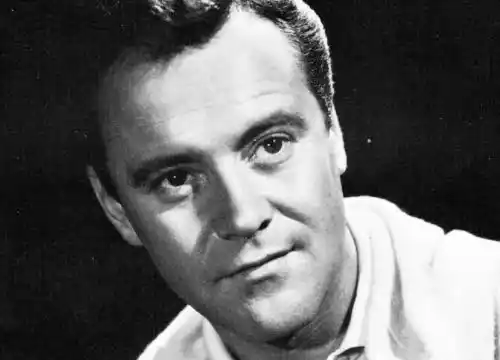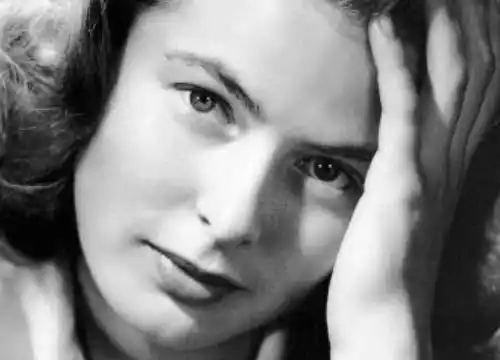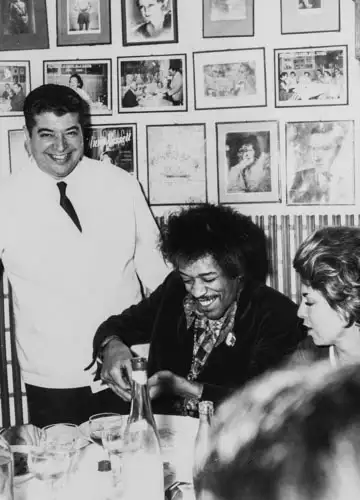Published:
Author: Antonio Maria Guerra
Fettuccine Alfredo
HISTORY, PLACES, INFO, INTERESTING FACTS

The history of Fettuccine Alfredo is a beautiful story made of fresh fettuccine, butter and Parmesan cheese. A story that begins in early 20th century Rome and is made up of love, culinary mastery and, above all, that all-Italian ability to create masterpieces of taste using just a few ingredients. Let’s discover it in this article, embarking on a journey that will take us from the capital of Italy to glittering Hollywood. Happy reading!

The history of Fettuccine Alfredo.
Leggendo gli articoli di questo sito si può facilmente capire che, in genere, è piuttosto difficile stabilire con precisione le origini di una specialità culinaria. Esistono però delle eccezioni: ad esempio, è possibile individuare con sicurezza l’anno di nascita delle Fettuccine Alfredo, una prelibatezza ‘romana de Roma’, incredibilmente celebre negli Stati Uniti e, cosa strana, non molto conosciuta in Italia.
The birth of a specialty and of a restaurant.
It was in 1908 that a Roman cook, Mr. Alfredo di Lelio, prepared egg fettuccine (‘fettuccine all’uovo’) to support his wife, who was weakened by pregnancy. He decided to render them exceptionally nutritious by adding a generous amount of butter and grated Parmesan cheese. The dish, made with love and the best ingredients, pleased the woman so much that it ended up on the menu of the restaurant where, at the time, he worked (*1).

In 1914, when Alfredo decided to open his own restaurant in Via della Scrofa (in the historical centre of rome), he did not fail to offer his customers the specialty he loved so much that he gave it his name: ‘Fettuccine Alfredo’. This attachment to the ‘blondes’ (as he called them) was probably one of the secrets of their success.
Hollywood stars visit Alfredo.
Alfredo’s fame grew when, at the end of the 1920s, the famous American actors Douglas Fairbanks and Mary Pickford had the opportunity to taste his cuisine. These two legends of Hollywood cinema were so enchanted by the man and his cuisine that they gave him a pair of solid gold cutlery (fork and spoon) as a token of their appreciation.

Needless to say, this esteem was not only expressed in the gift, but also in the publicity that they gave, more or less directly, to their favourite restaurant: it’s not surprising that, over the years, a large number of US movie stars visited the restaurant, specifically to taste the exquisite fettuccine.
A new restaurant.
It was in 1943, at the height of the Second World War, that Alfredo decided to sell his restaurant. But he did not say goodbye to the stoves, because a few years later, in 1950, he founded another one with his son Armando, which he called Il Vero Alfredo (*2) to distinguish it from the first one.
Notes:
*1: The restaurant, which no longer exists, belonged to Alfredo’s mother: Mrs. Angelina.
*2: The restaurant, located in Piazza Augusto Imperatore, is in business still today.
Let’s find out everything there is to know about Fettuccine Alfredo, from preparation to variations, from calories to pairings … and much more, in the article we have dedicated to the exquisite Roman speciality.
Rome: the birthplace of Fettuccine Alfredo.
Rome, the ‘cradle’ of Fettuccine Alfredo, is also and above all the ‘Eternal City’. Situated on the famous Seven Hills, it was founded, according to legend, by Romulus and Remus in 753 BC. Over the centuries it has become a treasure trove full of historical, artistic, and cultural wonders: so, it is no coincidence that it has been declared a UNESCO World Heritage Site.




Pasta with butter: an ancient recipe.
Fettuccine Alfredo can be rightfully considered a variation, or rather an evolution, of ‘pasta al burro’ (pasta with butter): a simple and yet very tasty specialty, dating back to a distant past. As evidence of this, it’s often quoted a famous cookbook from the 15th century, Libro De Arte Coquinaria (1450), written by Martino da Como, a cook much appreciated in many Renaissance courts: in his work, he mentions maccaroni romaneschi (Roman macaroni), seasoned with butter, grated cheese, and spices.

Fettuccine: the origin of the name.
According to some sources, the famous Italian pasta known as ‘fettuccine’ derives its name from the word “fettuccia”: a term commonly used to describe a thin, flat strip of fabric. This analogy perfectly describes the shape of this speciality, which resembles a ribbon. A very tasty kind of ribbon, as anyone who has tried it will tell you.

Serving fettuccine Alfredo: a fascinating spectacle.
Americans have a rather stereotypical image of Italians, which is often true. Among the habits they ascribe to the inhabitants of the Belpaese is that of gesticulation: a way of expressing oneself that they find extremely charming. Alfredo di Lelio must have understood this: so it’s not surprising that he served his famous fettuccine with theatrical movements. In fact, he used to stir and lift the pasta with studied movements to show off its golden reflections, causing a mixture of astonishment and admiration in his customers, as if they were witnessing a spectacular rite. As proof of this, there are numerous photographs of the celebrated chef showcasing his specialty at the table of some of Hollywood’s most famous film stars, who appear as genuinely impressed by his exuberance and friendliness.

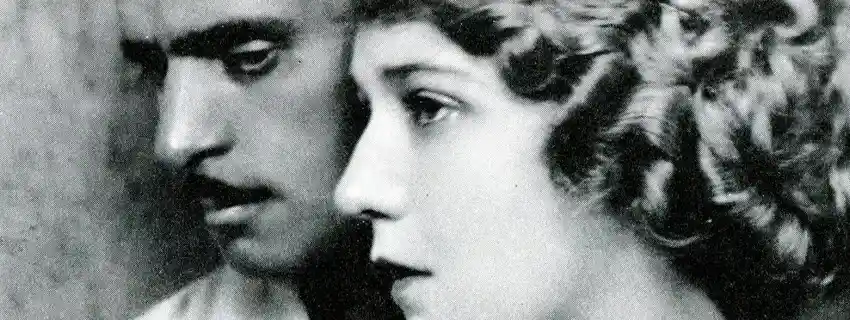
The Hollywood stars love Fettuccine Alfredo.
Between the 1920s and the 1960s, many film stars became ardent fans of Alfredo and its fettuccine. The credit for the discovery of this specialty should probably be given to the ‘golden couple’ of Hollywood at the beginning of the last century: Douglas Fairbanks, also known as the “King of Hollywood”, and Mary Pickford, also known as “America’s Sweetheart”. It’s possible that they were the ones who made the chef and his exquisite recipe so well known in the U.S. that a large number of movie stars wanted to try it: among the immortal actors who tasted it were Ava Gardner, Frank Sinatra, Clark Gable, James Stewart, Burt Lancaster, Gary Cooper, Ingrid Bergman and Jack Lemmon (to name but a few).

Fettuccine Alfredo history: two restaurants, one tradition.
Two are the Roman restaurants that represent and defend the tradition of the original Fettuccine Alfredo. The oldest was opened in 1914 by Alfredo di Lelio in Via della Scrofa, hence the name ‘Alfredo alla Scrofa’. Although it was sold in 1943, the new owners committed themselves to following in the founder’s footsteps from the beginning.
A few years later, in 1950, Mr Alfredo founded another restaurant with his son, which he called ‘Il Vero Alfredo’ to distinguish it from the previous one. This one too is open still today.

Alfredo alla Scrofa: the birthplace of Fettuccine Alfredo.
This article was realized in collaboration with ‘Alfredo alla Scrofa’: the restaurant, founded by Alfredo di Lelio, which was, in fact, the birthplace of Fettuccine Alfredo.
Here are its contact details:
Contact details
Address: Via della Scrofa, 104/a, 00186 Rome (Italy)
Website: alfredoallascrofa.com
Mail: info@alfredoallascrofa.com
Tel.: +39 06 6880 6163
Copyright information.
The images displayed in this page belong to WebFoodCulture and to the Restaurant Alfredo alla Scrofa (published by kind permission), with the exception of:
Pubblic Domain Images
Creative Commons Images
- “Fettuccine” by TheGirlsNY is licensed under CC BY-SA 2.0.
- “Mary Pickford and Douglas Fairbanks” by classic film scans is licensed under CC BY 2.0.
- “Rome” by Nick Kenrick.. is licensed under CC BY 2.0.
- “Mary Pickford and Douglas Fairbanks” by classic film scans is licensed under CC BY 2.0.

